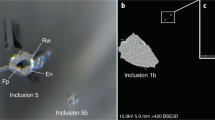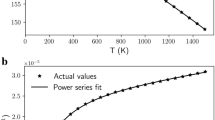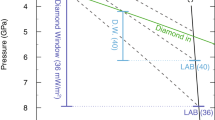Abstract
The ultimate origin of water in the Earth’s hydrosphere is in the deep Earth—the mantle. Theory1 and experiments2,3,4 have shown that although the water storage capacity of olivine-dominated shallow mantle is limited, the Earth’s transition zone, at depths between 410 and 660 kilometres, could be a major repository for water, owing to the ability of the higher-pressure polymorphs of olivine—wadsleyite and ringwoodite—to host enough water to comprise up to around 2.5 per cent of their weight. A hydrous transition zone may have a key role in terrestrial magmatism and plate tectonics5,6,7, yet despite experimental demonstration of the water-bearing capacity of these phases, geophysical probes such as electrical conductivity have provided conflicting results8,9,10, and the issue of whether the transition zone contains abundant water remains highly controversial11. Here we report X-ray diffraction, Raman and infrared spectroscopic data that provide, to our knowledge, the first evidence for the terrestrial occurrence of any higher-pressure polymorph of olivine: we find ringwoodite included in a diamond from Juína, Brazil. The water-rich nature of this inclusion, indicated by infrared absorption, along with the preservation of the ringwoodite, is direct evidence that, at least locally, the transition zone is hydrous, to about 1 weight per cent. The finding also indicates that some kimberlites must have their primary sources in this deep mantle region.
This is a preview of subscription content, access via your institution
Access options
Subscribe to this journal
Receive 51 print issues and online access
$199.00 per year
only $3.90 per issue
Buy this article
- Purchase on Springer Link
- Instant access to full article PDF
Prices may be subject to local taxes which are calculated during checkout


Similar content being viewed by others
References
Smyth, J. R. β-Mg2SiO4: a potential host for water in the mantle? Am. Mineral. 72, 1051–1055 (1987)
Chen, J., Inoue, T., Yurimoto, H. & Weidner, D. J. Effect of water on olivine- wadsleyite phase boundary in the (Mg,Fe)2SiO4 system. J. Geophys. Res. Lett. 29, 1875 (2002)
Kohlstedt, D. L., Keppler, H. & Rubie, D. C. Solubility of water in the α, β and γ phases of (Mg,Fe)2SiO4 . Contrib. Mineral. Petrol. 123, 345–357 (1996)
Smyth, J. R. et al. Structural systematics of hydrous ringwoodite and water in Earth’s interior. Am. Mineral. 88, 1402–1407 (2003)
Bercovici, D. & Karato, S. Whole-mantle convection and the transition zone water filter. Nature 425, 39–44 (2003)
Bolfan-Casanova, N. Water in the Earth’s mantle. Mineral. Mag. 69, 229–258 (2005)
Hirschmann, M. Water, melting and the deep Earth H2O cycle. Annu. Rev. Earth Planet. Sci. 34, 629–653 (2006)
Huang, X., Xu, Y. & Karato, S. Water content in the transition zone from electrical conductivity of wadsleyite and ringwoodite. Nature 434, 746–749 (2005)
Xu, Y., Shankland, T. J. & Rubie, D. C. Electrical conductivity of olivine, wadsleyite and ringwoodite under upper-mantle conditions. Science 280, 1415–1418 (1998)
Yoshino, T., Manthilake, G., Matsuzaki, T. & Katsura, T. Dry mantle transition zone inferred from the conductivity of wadsleyite and ringwoodite. Nature 451, 326–329 (2008)
Khan, A. & Shankland, T. J. A geological perspective on mantle water content and melting: inverting electromagnetic sounding data using laboratory-based electrical conductivity profiles. Earth Planet. Sci. Lett. 317–318, 27–43 (2012)
Agee, C. B. in Ultrahigh-Pressure Mineralogy (ed. Hemley, R. J. ) 165–203 (Rev. Mineral. 37, Mineralogical Society of America, 1998)
Ringwood, A. E. & Major, A. The system Mg2SiO4-Fe2SiO4 at high pressures and temperatures. Phys. Earth Planet. Inter. 3, 89–108 (1970)
Ye, Y. et al. Compressibility and thermal expansion of hydrous ringwoodite with 2.5 wt% H2O. Am. Mineral. 97, 573–582 (2012)
Harris, J. W., Hutchison, M. T., Hursthouse, M., Light, M. & Harte, B. A new tetragonal silicate mineral occurring as inclusions in lower mantle diamonds. Nature 387, 486–488 (1997)
Harte, B. & Harris, J. W. Lower mantle associations preserved in diamonds. Mineral. Mag. 58A, 384–385 (1994)
Harte, B., Harris, J. W., Hutchison, M. T., Watt, G. R. & Wilding, M. C. in Mantle Petrology: Field Observations and High Pressure Experimentation Vol. 6 (eds Fei, Y. & Bertka, C. M. ) 125–153 (Geochem. Soc. Spec. Publ., The Geochemical Society, 1999)
Hutchison, M. T., Cartigny, P. & Harris, J. W. in Proc. 7th Int. Kimberlite Conf. (eds Gurney, J. J., Gurney, J. L., Pascoe, M. D. & Richardson, S. H. ) 372–382 (Red Roof Design, 1999)
Hutchison, M. T., Hursthouse, M. B. & Light, M. E. Mineral inclusions in diamonds: associations and chemical distinctions around the 670-km discontinuity. Contrib. Mineral. Petrol. 142, 119–126 (2001)
Brenker, F. et al. Detection of a Ca-rich lithology in the deep (>300 km) convecting mantle. Earth Planet. Sci. Lett. 236, 579–587 (2005)
Stachel, T., Brey, G. P. & Harris, J. W. Inclusions in sublithospheric diamonds: glimpses of deep Earth. Elements 1, 73–78 (2005)
Stachel, T., Harris, J. W., Brey, G. P. & Joswig, W. Kankan diamonds (Guinea) II: lower mantle inclusion paragenesis. Contrib. Mineral. Petrol. 140, 16–27 (2000)
Bulanova, G. et al. Mineral inclusions in sublithospheric diamonds from Collier 4 kimberlite pipe, Juina, Brazil: subducted protoliths, carbonated melts and primary kimberlite magmatism. Contrib. Mineral. Petrol. 160, 489–510 (2010)
Hayman, P. C., Kopylova, M. G. & Kaminsky, F. V. Lower mantle diamonds from Rio Soriso (Juina area, Mato Grosso, Brazil). Contrib. Mineral. Petrol. 149, 430–445 (2005)
Tappert, R., Stachel, T., Harris, J. W., Shimizu, N. & Brey, G. P. Mineral inclusions in diamonds from the Panda kimberlite, Slave Province, Canada. Eur. J. Mineral. 17, 423–440 (2005)
Harte, B. Diamond formation in the deep mantle: the record of mineral inclusions and their distribution in relation to mantle dehydration zones. Mineral. Mag. 74, 189–215 (2010)
Jacobsen, S. D., Smyth, J. R., Spetzler, H., Holl, C. M. & Frost, D. J. Sound velocities and elastic constants of iron-bearing hydrous ringwoodite. Phys. Earth Planet. Inter. 143–144, 47–56 (2004)
Blanchard, M., Balan, E. & Wright, K. Incorporation of water in iron-free ringwoodite: a first principles study. Am. Mineral. 94, 83–89 (2009)
Bolfan-Casanova, N., Keppler, H. & Rubie, D. C. Water partitioning between nominally anhydrous minerals in the MgO-SiO2-H2O system up to 24 GPa: implications for the distribution of water in the Earth’s mantle. Earth Planet. Sci. Lett. 182, 209–221 (2000)
Keppler, H. & Bolfan-Casanova, N. in Water in Nominally Anhydrous Minerals (eds Keppler, H. & Smyth, J. R. ) 193–230 (Rev. Mineral. 62, Mineralogical Society of America, 2006)
Kleppe, A. K., Jephcoat, A. P. & Smyth, J. R. Raman spectroscopic study of hydrous γ-Mg2SiO4 to 56.5 GPa. Phys. Chem. Miner. 29, 473–476 (2002)
Kelbert, A., Schultz, A. & Egbert, G. Global electromagnetic induction constraints on transition-zone water content variations. Nature 460, 1003–1006 (2009)
Chen, M., El Goresy, A. & Gillet, P. Ringwoodite lamellae in olivine: clues to olivine–ringwoodite phase transition mechanisms in shocked meteorites and subducting slabs. Proc. Natl Acad. Sci. USA 101, 15033–15037 (2004)
Brenker, F. E. et al. Carbonates from the lower part of the transition zone or even the lower mantle. Earth Planet. Sci. Lett. 260, 1–9 (2007)
Silversmit, G. et al. Polycapillary based μ-XAS and confocal μ-XANES at a bending magnet source of the ESRF. J. Phys. Conf. Ser. 190, 012036 (2009)
Yamanaka, T. Crystal structures of Ni2SiO4 and Fe2SiO4 as a function of temperature and heating duration. Phys. Chem. Miner. 13, 227–232 (1986)
Fujino, K. & Sasaki, S. X-ray determination of electron distributions in forsterite, fayalite and tephroite. Acta Crystallogr. B 37, 513–518 (1981)
Finger, L. W., Hazen, R. M., Zhang, J., Ko, J. & Navrotsky, A. The effect of Fe on the crystal structure of wadsleyite β-(Mg1−xFex)2SiO4, 0.00 ≤ x ≤ 0.40. Phys. Chem. Miner. 19, 361–368 (1993)
Nasdala, L. et al. Spectroscopic 2D-tomography: residual pressure and strain around mineral inclusions in diamonds. Eur. J. Mineral. 15, 931–935 (2003)
Grimsditch, M. H., Anastassakis, E. & Cardona, M. Effect of uniaxial stress on the zone-centre optical phonon of diamond. Phys. Rev. 18, 901–904 (1978)
Baonza, V. G., Taravillo, M., Arencibia, A., Caceres, M. & Nunez, J. Diamond as a pressure sensor in high-pressure Raman spectroscopy using sapphire and other gem anvil cells. J. Raman Spectrosc. 34, 264–270 (2003)
Kleppe, A. K., Jephcoat, A. P., Smyth, J. R. & Frost, D. J. On protons, iron and the high pressure behavior of ringwoodite. J. Geophys. Res. 29, 2021 (2002)
Liu, L., Lin, T., Mernagh, P. & Inoue, T. Raman spectra of hydrous γ-Mg2SiO4 at various pressure and temperatures. Phys. Chem. Miner. 29, 181–187 (2002)
Feng, L., Lin, Y., Hu, S., Xu, L. & Miao, B. Estimating compositions of natural ringwoodite in the heavily shocked Grove Mountains 052049 meteorite from Raman spectra. Am. Mineral. 96, 1480–1489 (2011)
Koch-Müller, M. & Rhede, D. IR absorption coefficients for water in nominally anhydrous high-pressure minerals. Am. Mineral. 95, 770–775 (2010)
Matveev, S. & Stachel, T. FTIR spectroscopy of OH in olivine: a new tool in kimberlite exploration. Geochim. Cosmochim. Acta 71, 5528–5543 (2007)
Libowitzky, E. & Rossman, G. R. Principles of quantitative absorbance measurements in anisotropic crystals. Phys. Chem. Miner. 23, 319–327 (1996)
Acknowledgements
D.G.P. acknowledges CERC funding for this study. F.N. is supported by ERC Starting Grant 307322. Support from the Alfred P. Sloan Foundation’s Deep Carbon Observatory project created this research partnership. We thank T. Stachel for comments on the manuscript plus access to the FTIR instrument at the De Beers Laboratory of Diamond Research at the University of Alberta, and we thank J. Harris for discussions. Sample JUc29 was provided by Trigon GeoServices Ltd.
Author information
Authors and Affiliations
Contributions
D.G.P. had the idea for the study, wrote the manuscript and helped perform the Raman and FTIR measurements. F.E.B. performed the Raman measurements and ion-milling and made compositional estimates. F.N. performed X-ray measurements. J.M. and L.N. first identified the inclusion as ringwoodite. M.T.H. selected the diamond for this study and assisted with manuscript preparation and geological background. S.M. performed the FTIR measurements and the water content estimate. K.M. assisted with manuscript preparation. G.S., S.S., B.V. and L.V. performed the synchrotron X-ray mapping measurements.
Corresponding author
Ethics declarations
Competing interests
The authors declare no competing financial interests.
Extended data figures and tables
Extended Data Figure 1 Image of JUc29 diamond and the ringwoodite-walstromite inclusion.
a, Monochrome image of diamond JUc29 taken under incident light, with the ringwoodite-walstromite inclusion pair highlighted by a red square. The irregular shape and hexagonal pits in the diamond are signs of significant resorption. b, Enlarged view of the area of the host diamond (rotated 90° relative to a) containing the ringwoodite-walstromite inclusion pair. The shadow behind the rectangular area outlining the inclusion pair is probably a stress fracture in the diamond.
Extended Data Figure 2 Three-dimensional confocal μXRF view of two-phase ringwoodite-walstromite inclusion.
Three-dimensional confocal μXRF view of two-phase inclusion within JUc29 diamond, showing Ca (red) and Fe (green) low-intensity isosurfaces for confocal μXRF, with blue representing the diamond host (derived from scatter intensity). Scale bar, 40 μm.
Extended Data Figure 3 Single-crystal X-ray diffraction image showing the main diffraction peaks of ringwoodite.
CCD image collected by a STOE STADI IV single-crystal diffractometer, using monochromatized MoKα radiation (λ = 0.71073 Å), working at 50 kV and 40 mA and with an exposure time of 60 s. The image shows the main four diffraction peaks of ringwoodite (outlined by blue circles and labelled “RINGW” for clarity), that is, the planes (113) at 2.44 Å, (440) at 1.40 Å, (220) at 2.81 Å and (115) at 1.51 Å, in their exact order of expected relative intensity, which is well determined by CCD. The expected fifth peak, at about 2.02 Å, was not found because it is covered by the very intense diamond peak, which occurs at the same d spacing (large and bright peaks in figure). In addition to the ringwoodite diffraction peaks, the main peaks of the host diamond are present as the most intense peaks (labelled ‘diamond’). The characteristic peaks of quartz are evident (labelled ‘quartz’). Secondary quartz crystals occur in resorption pits on the sample surface but quartz is not included within the diamond. The diffraction rings result from clay minerals again present on the surface of the diamond. Finally, at least one diffraction peak, that occurring at 3.03 Å, probably results from CaSiO3-walstromite (labelled ‘walstromite?’).
PowerPoint slides
Rights and permissions
About this article
Cite this article
Pearson, D., Brenker, F., Nestola, F. et al. Hydrous mantle transition zone indicated by ringwoodite included within diamond. Nature 507, 221–224 (2014). https://doi.org/10.1038/nature13080
Received:
Accepted:
Published:
Issue Date:
DOI: https://doi.org/10.1038/nature13080
This article is cited by
-
Hydrogen partitioning between stishovite and hydrous phase δ: implications for water cycle and distribution in the lower mantle
Progress in Earth and Planetary Science (2024)
-
Diamond sources of the Juína region, Amazonian craton: textural and mineral chemical characteristics of Kimberley-type pyroclastic kimberlites
Mineralogy and Petrology (2024)
-
Magnesium oxide-water compounds at megabar pressure and implications on planetary interiors
Nature Communications (2023)
-
Weak upper-mantle base revealed by postseismic deformation of a deep earthquake
Nature (2023)
-
Extreme redox variations in a superdeep diamond from a subducted slab
Nature (2023)
Comments
By submitting a comment you agree to abide by our Terms and Community Guidelines. If you find something abusive or that does not comply with our terms or guidelines please flag it as inappropriate.



